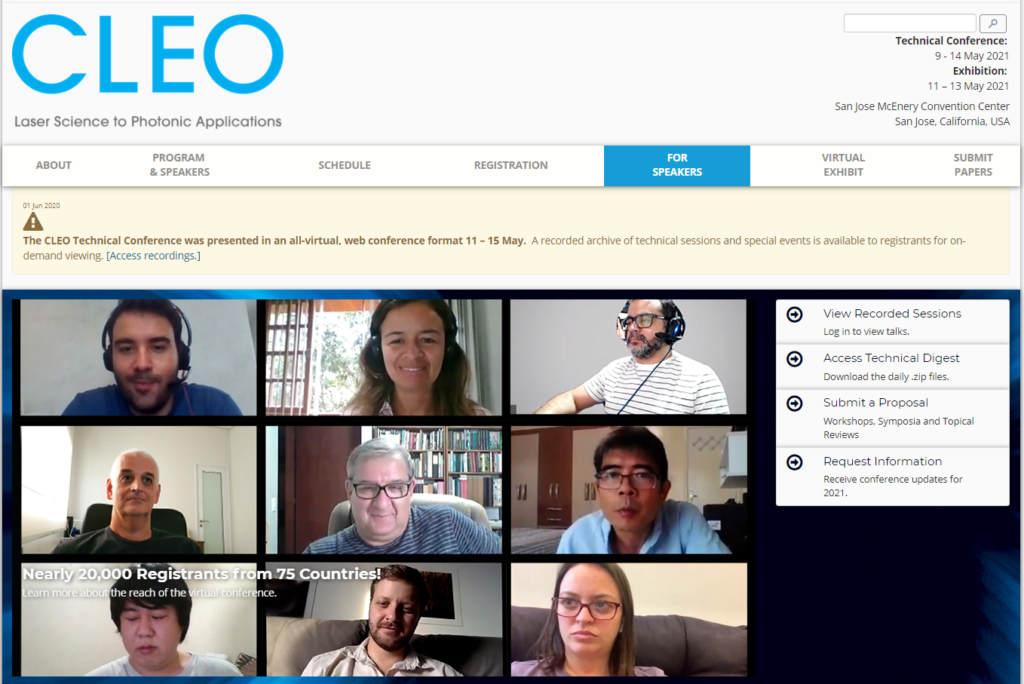The Open Bioinformatics Foundation (OBF) Event Fellowship program aims to promote diverse participation at events promoting open source bioinformatics software development and open science practices in the biological research community. Pengfei Fan, a researcher from Queen Mary University of London, was supported to participate in CLEO 2020 by this fellowship granted to him in the application round-1 of 2020. Find more information here.
During the last two decades, we are witnessing a fascinating growth of computational imaging (CI) methods, e.g. tomography, compressive sensing and 3D/super-resolved/lensless microscopy, and artificial intelligence (AI) algorithms, mainly machine learning and deep learning, both from the theoretical (mathematical) and practical (experimental) point of view. New computational capabilities in terms of, e.g., big data, large scale optimisation, neural networks and highly parallel computing, are facilitating further improvements in numerically enhanced imaging surpassing the limitations imposed by ‘classical’ all-optical information processing systems. It is joyful to observe how CI and AI merge to innovatively address challenging tasks fuelled by wide-spreading applications in 3D imaging, biomedicine, microscopy and general physics of light propagation in scattering media, to name just a few. When designing a computational imaging technique, one needs to originally link the applicable data acquisition scheme with the capable image reconstruction algorithm, often aided by learning-based frameworks employed not only for image classification and interpretation but also for image formation and final outcome restoration. As the AI stimulatory development continues to flourish, open-source tools and software, especially deep learning framework and platform, have become a key ingredient of modern science. Hundreds of software packages, libraries, and applications have become essential tools.
We count on open-source software and tools in almost every research project, and it is also our responsibility to maintain and develop them. I have been engaging in a research project on deep learning for optical imaging and sensing, and our group at Queen Mary University of London are developing a robust ultrathin multimode fibre based endoscope. Progress in bioinformatics relies on new techniques for investigating the complex dynamics of biological systems. This research theme will develop the crucial role for Data Science and Artificial Intelligence in answering many fundamental questions in genomics and biology regarding the structure and function of genomes, the molecular interplay within cells and organs, the role, shape and functions of proteins as well as advancing imaging techniques.
 An All-virtual Presentation of CLEO 2020 Technical Conference (Screenshot from the event, shared with permission)
An All-virtual Presentation of CLEO 2020 Technical Conference (Screenshot from the event, shared with permission)
CLEO is the world’s premier international forum to learn about innovative advances, research and new technologies from the optical science industry. Biomedical imaging and sensing is always an essential part of CLEO every year. The CLEO 2020 Technical Conference was held as scheduled in a first-ever, all-virtual format. The conference reached almost 20,000 registrants from 75 countries. By the end of the conference, 33,322 minutes of programming was presented. 248 Technical, Poster and Dynamic ePoster Sessions equated to more than 2,000 scientific presentations — all delivered in a combination of live and pre-recorded sessions and demonstrating a wide breadth of advancements and discoveries. The session recordings are now available on the conference website for individuals who registered for CLEO.
The first day of the conference started with an exciting symposium on Integrated Photonics for Neural Networks and Deep Learning, which was presided by Ozdal Boyraz from University of California Irvine. After the symposium, participants started travelling to different virtual ‘rooms’ to attend their favourite sessions. I presented our current research results at Fiber Based Imaging session, and our software, code and datasets have been published and were highlighted again. We were happy to share the datasets at the conference to catalyse the impact of data science and AI across the world. Specifically, these interesting datasets could be made the focus of a data study event or an impactful long-term project. As data owners, we have been given an opportunity and support to form a data science and bioinformatics community around our data and kick-start interdisciplinary or translational project collaborations.
The second day of the conference was kicked off with ‘Meet the OSA Editors’ talk, which was followed by two content-rich plenary sessions. The first one is on Intelligent Optical Synthesizer by Professor Kaoru Minoshima from University of Electro-Communications. Another is on Silicon Photonics by John Bowers, Director of the Institute for Energy Efficiency and Professor, University of California Santa Barbara. On the third day, there was also one plenary session on Advanced Resources for Optical Quantum Information Processing by Paul Kwiat from University of Illinois at Urbana-Champaign. I also participated in one Special Symposium on Artificial Intelligence for Photonics Imaging and Sensing, where Lei Tian, from Boston University, gave an invited talk about Deep learning-based computational biomedical microscopy with uncertainty quantification. On the fourth day and fifth day, I went through the fantastic Joint Poster Sessions: Micro- and Nano-Photonic Devices, and Photonic Innovations for Biological Sciences respectively.
To conclude, I would like to thank the OBF for providing me with the OBF Event Fellowship to cover the presentation fee to participate in CLEO 2020. This fellowship was an excellent opportunity to connect with open source and open science enthusiasts, and I firmly believe that this community will ideally promote open-source software development and advocate diversify in the years to come.